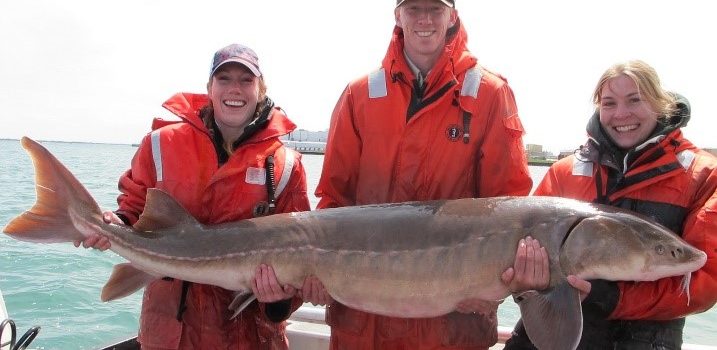
If you build it, sturgeon will come
Imagine a fish that existed at the same when time dinosaurs walked the earth. It has a massive, torpedo shaped body, five rows of bony plates, mottled grey skin, and four white whiskers that cascade from the bottom of a blunt snout. These magnificent and beautiful fish are sturgeon.

Often referred to as a living fossil, sturgeon have been around for over 136 million years. Though their size can be intimidating, sturgeon are docile, bottom-feeders with a large, sucker-like mouth they can stick out to collect food items like snails, insects, and small fish. There are nine sturgeon species in the United States but only one species, the Lake Sturgeon, lives in the Great Lakes.
As their name implies, Lake Sturgeon are often found in lakes, but they are highly migratory and will swim long distances up rivers to find the right habitat to lay their eggs. The little fish that hatch will imprint on the river where they were born and later return to that same system to reproduce. Unlike most fish in the Great Lakes, sturgeon can live for a really long time – more than 100 years!

Lake Sturgeon were once quite abundant in the Great Lakes, but human influences like overharvesting, pollution, damming rivers, and habitat degradation have reduced their numbers to less than 1% of the historic population. The restoration of sturgeon populations is often limited by a lack of suitable spawning habitat (areas for the fish to lay their eggs).

Now, a team of scientists are working hard to rebuild rocky habitats that are critical for sturgeon and other native species to spawn. In the St. Clair-Detroit River System, these rocky areas were destroyed when shipping channels were constructed in the late 1800’s.

Between 2004 – 2017, the U.S. Fish and Wildlife Service has worked with a diverse team of federal, state, and private organizations to construct six spawning reefs that restore 12.6 acres of rocky habitat in the Detroit-St. Clair River System. The reefs, meticulously constructed, are comprised of large (4 – 8 inch) rock material like limestone, coal cinders, and fieldstone. When piled together, the rocks form crevices for fish eggs to settle into and be protected from predators and strong currents.

To construct the reefs, a construction worker unloads rocks from a barge anchored over the exact spot where the reef is to be built. Each scoop of rock is precisely placed in an area with the right water velocity and depth. One of the largest reefs created, Hart’s Light Reef in the St. Clair River, measures 1007 feet long, 165 feet wide and is about 2 feet deep.
The results from constructing these reefs have been incredible. Lake Sturgeon began spawning on the reefs right after they were built! And not just Lake Sturgeon; 17 other native fish species are spawning on the reefs, including important sport fish like Walleye, White Bass, Lake Whitefish, and Smallmouth Bass. Each year, biologists are finding lots of baby fish around the reefs, but these new reefs provide more than just spawning habitat; 15 additional species including Yellow Perch, Northern Pike, and Mudpuppy (an aquatic salamander!) utilize the reefs in others ways such as seeking refuge or finding food.
Before the reefs were constructed, only two fish species were documented spawning in the area: Walleye & White Sucker. It was the creation of these spawning reefs that attracted more than 30 species and helped restore Lake Sturgeon populations. This project is a true testament of how by restoring habitat for one species, you can help an entire community of species.
It’s amazing what a collaborative team of passionate, ambitious people can create. While there were some lessons learned along the way on how to build the reefs, it was the incredible collaboration from a huge team of people that really led the way for this project’s success.
Partners in this project include: U.S. Fish and Wildlife Service, U.S. Geological Survey Great Lakes Science Center, Michigan Wildlife Conservancy, Environment Canada, the U.S. Environmental Protection Agency, the University of Michigan Water Center, the St. Clair and Detroit River Sturgeon for Tomorrow, International Wildlife Refuge Alliance, Michigan Department of Natural Resources, Michigan Sea Grant, Essex Region Conservation Authority, Ontario Ministry of Natural Resources, National Fish and Wildlife Foundation, Detroit River Canadian Cleanup, BASF Corporation, DTE Energy, Landmark Engineers Inc., the Wildlife Habitat Council, and the Great Lakes Restoration Initiative.
Want to run with the sturgeon or take a sturgeon cruise? Check out the Blue Water Sturgeon Festival on the St. Clair River in Port Huron, Michigan!!

Jessica Collier is a 2018 Sea Grant Knauss Fellow and the coastal and marine resource specialist with the U.S. Fish & Wildlife Service Coastal Program.
